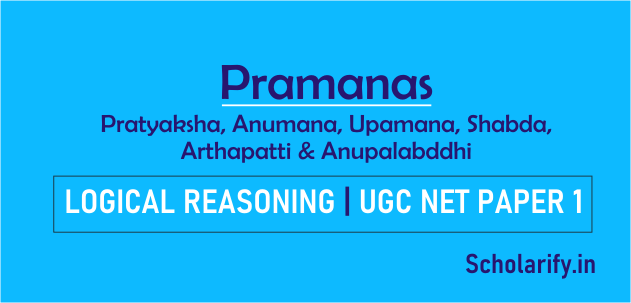
Pramanas: Pramana (“sources of knowledge” or “measure”) is an epistemological term in Indian and Buddhist philosophies referring to the means by which a person obtains accurate and valid knowledge (Prama, pramiti) of the world.
Bases of Pramanas
In obtaining Prama, or correct knowledge, Pramana forms one part of a triputi (trio):
- Pramata, the subject (the knower)
- Pramaņa, the means of obtaining the knowledge
- Prameya, the object ( the knowable)
UNIT VI – Logical Reasoning (Click below on the topic to read the study notes)
|
UGC NET Study Materials for Paper 1 (eBook with MCQ) ⇒ Download Now |
The three-principal means of knowledge are:
- Pratyaksa (Perception)
- Anumana (Inference), and
- Sabda (Word)
The Sabda (word) is derived from the Veda, which is considered to be inherently valid. Some philosophers include the statements of reliable persons (apta-vakya) in the concept of Word (sabda), and add two additional means of obtaining knowledge:
- Upamana (Analogy): enables one to hold on the meaning of a word by analogy, and
- Arthapatti (postulation or Implication): appeals to common sense according to circumstances.
The ancient and medieval Indian books identify six Pramanas, including Anupalabdhi (non-perception, negative/cognitive proof) as correct means of accurate knowledge and to truths.
The most widely accepted and discussed pramanas are:
- Pratyakṣa (Perception)
- Anumāṇa (Inference)
- Śabda (word, testimony)
- Upamāṇa (Comparison, Analogy)
- Arthāpatti (Postulation, Presumption, derivation from circumstances)
- Anupalabdi (non-perception, cognitive proof using non-existence)
Different Ancient Schools and Accepted Pramanas
| Schools | Accepted Pramanas |
| Carvaka school | Click to view |
| Vaisheshika school | Click to view |
| Sankhya, Yoga, Vishishtadvaita Vedanta, and Dvaita Vedanta schools | Click to view |
| Nyaya school | Click to view |
| Prabhakara Mimamsa school | Click to view |
| Advaita Vedanta and Bhatta Mimamsa schools | Click to view |
The Advaita Vedanta recognizes six pramanas, namely, Pratyaksa(perception), Anumana (inference), Sabda or Agama (verbal testimony), Upamana (comparison), Arthapatti (presumption) and Anupalabdhi or Abhava(nonapprehension).
Pratyakṣa (Perception)
The word ‘pratyaksa’ consists of two parts viz. “prati” meaning near or before or related to and “aksi” meaning eye. So, it means the process through which immediate knowledge of an object arises or it means the instrument by which the object is conceived.
Types of Pratyaksha
Pratyaksha is broadly divided into two types:
Direct perception (Anubhava): In this type of perception, the knowledge of an object arises when it comes in contact with sense organs; smell (nose), touch (skin), form (eyes), sound (ears) and taste (tongue).
Traditionally, there are four ways of obtaining pratyaksha. They are:
Anumāṇa (inference) Pramanas
Anumana literally means such knowledge that follows some other knowledge. Anumāṇa (inference) is the knowledge of an object due to a previous knowledge of some sign or mark. In Anumana Pramana, we arrive at the knowledge of an object through the medium of two acts of knowledge or propositions.
There are definite steps to be followed in all inferential knowledge. The following steps are accepted for logical deduction of knowledge by the teachers of Advaita Vedanta :
Śabda (word, testimony) Pramanas
Sabda or Shabda or verbal testimony is also called ‘apta-vakyas’ (statement of a trustworthy person, and Agama (authentic word). A verbal statement can be uttered or written, is human’s most potent instrument for transmitting knowledge.
Upamāṇa (comparison, analogy) Pramanas
According to the Mimamsakas and Advaitins,
The methodology of Upamana for getting knowledge is seen as distinct from mere inference, and is thus accepted as a valid mediate method of knowledge.
For example, a person who has ….
Upamana is a distinct means of knowledge, and it can not be clubbed under Anumāṇa (Inference). We cannot have a universal proposition that a thing is similar to whatever is identical to it. Such knowledge can not be gained without the observation of the two same things together.
Arthāpatti (postulation, presumption) Pramanas
Arthapatti means postulation, supposition, or presumption of a fact. Arthapatti is a distinct valid One of the classic examples of this method of knowledge is Shyam; a fat person says that he never …
Anupalabdi, Abhava (non-perception, cognitive proof using non-existence)
According to the Advaitins and the Mimasaka school of Kumarila Bhatt, Anupalabdhi is considered to be a separate independent Pramana. Anupalabdhi literally means non-apprehension. Its non-perception apprehends the non-existence of a thing.
Related Topics:
UGC NET Syllabus 2020 (Updated): Paper 1 and 2
Solved Question Papers of UGC NET Paper 1
UGC NET Study Materials for Paper 1 (Download PDF)
Official Website for UGC NET
thank you so much for providing these notes. very systematically arranged and explained. thank you thank you thank you.
Thanks for the appreciation.
your notes are very good
Thanks for the appreciation.
Nice explanation of terms for people who are studying Vedanta for the first time. Thank you!